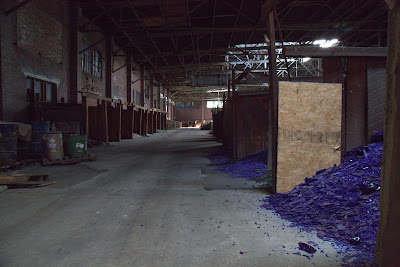Today, our class visited the Paul Wissmach Glass factory located in Paden City, West Virginia. Wissmach is known world-wide for their variety of colorful, rolled sheet glass; which is commonly used in stained glass applications. The glass produced in this factory is available in many colors, patterns, and transparent qualities. Over 5000 colors and tints have been produced by this company.
In order to make their glass, they must first create the correct mixture of glass using the basic raw materials as mentioned in earlier blogs. All raw materials are shipped in via railroad - which runs right behind the factory.
Once mixed, the raw ingredients are placed in a box called a hopper, which is numbered to indicate color and the appropriate furnace it will be placed in. One batch will make approximately 1500 sqft of sheet glass.
When they are ready to create a new load, the hopper is lifted by crane over to the area where the furnaces are and loaded into a wagon. From their they are shoveled by hand into the appropriate furnace and heated until used.
Glass is scooped out of the furnace with a large ladle on wheels. In the process I observed, 2 different colors were used.
The molten glass is then wheeled over to the top of the machine and poured on a metal surface where 2 other workers begin mix the glass together with metal tools. It is then shoved down into the machine where it is rolled into a flat sheet of glass.
In the annealing process, water is used to help cool the glass through a special ventilation technique. The steam from the water acts as a barrier between the glass and the mesh bedding to ensure it does not stick to the conveyor belt. (In some instances, water can be used to help give glass a specific texture - as in the mystic #45 line)
At the end of the line, glass is carefully slid onto a metal table by 2 workers and cut into appropriate sizes and shapes. Broken pieces are either salvaged, sold for $1/lbs, or sold as cullet to local glass company Marble King.
Glass is then either stored or packaged with poplar tree shavings and labeled for shipping.

















A lot of detail about the process of making rolled glass. It was great that we were able to go see the process up close.
ReplyDeleteI still can't believe that we were able to get on the production floor and see the process up close.
ReplyDeleteNice panorama and i like the way you are using text pic., text pic. format. I look forward to seeing the completed post.
ReplyDeleteLooking at those pictures brings to mind just how hot it was on the floor. It's still mind-blowing how those guys are able to deal with that day in, day out.
ReplyDelete